Being Bhutanese
In a region where borders are unstable and often disputed, Bhutan has crafted a national identity that distinguishes it from its neighbours and emphasises its uniqueness and sovereignty.
Cover Photo: Satellite photo by Landsat. Redrawn from data by Google, SIO, NOAA, US Navy, NGA, GEBCO.
You can learn a lot about a country from its airport. Like the ornate gates of ancient cities, 21st-century terminals are statements of identity, built with aspirational energy and utopian intent. Bhutan’s Paro Airport, opened in 1999, is no exception. But rather than soaring concrete, latticed steel and sparkling glass, arriving travellers encounter whitewashed walls, hand-carved window frames, and intricately painted woodwork. Fantastical demons stare from patterned pillars at the end of the luggage carousel. Instead of a hymn to a high-tech future, it is a Himalayan palace with an Airbus parked outside.
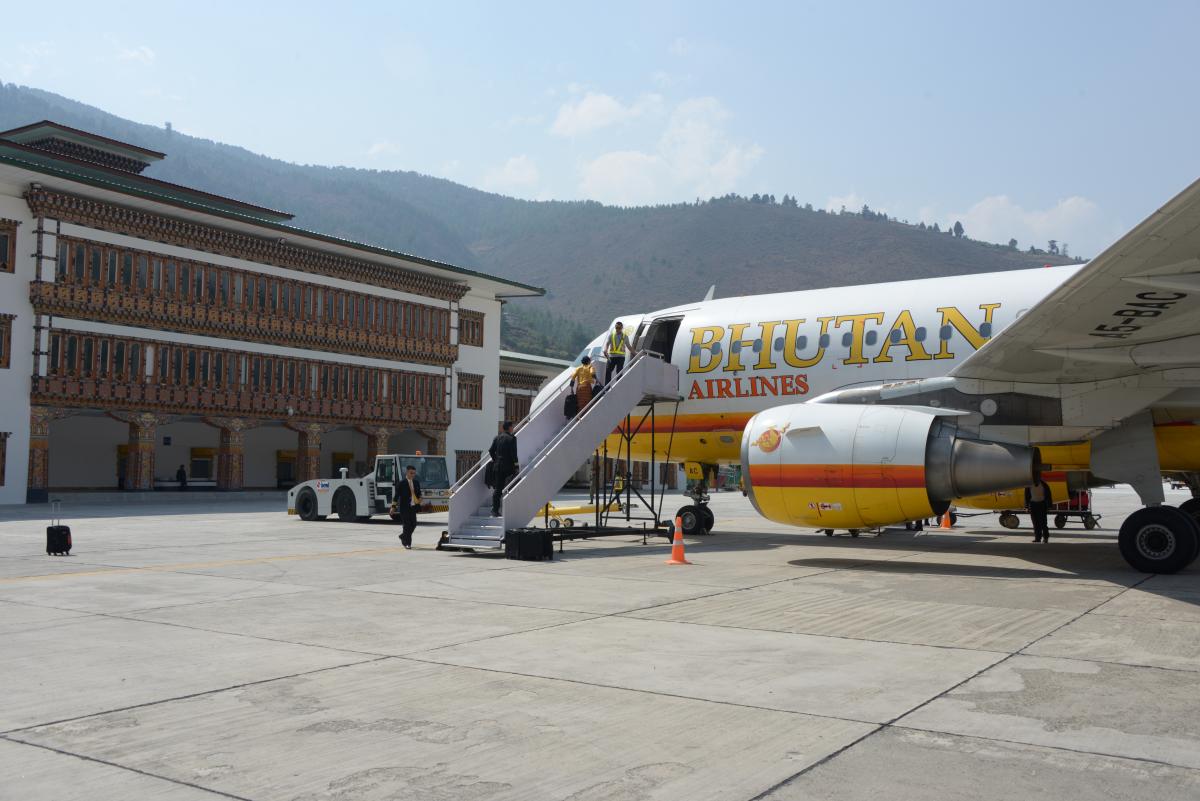
Paro Airport, the sole international airport in the Kingdom of Bhutan. To book travel to Bhutan, tourists must hire a licensed tour operator and pay $250 (€223) per day for a package that includes accommodation, food and transport. Also included in the daily price is a $65 (€58) fee that goes towards education, healthcare and poverty alleviation programs. While in 1974 Bhutan hosted just 287 tourists, by 2015 that number had leapt to 155,121. (Photo: Peter Bilak)
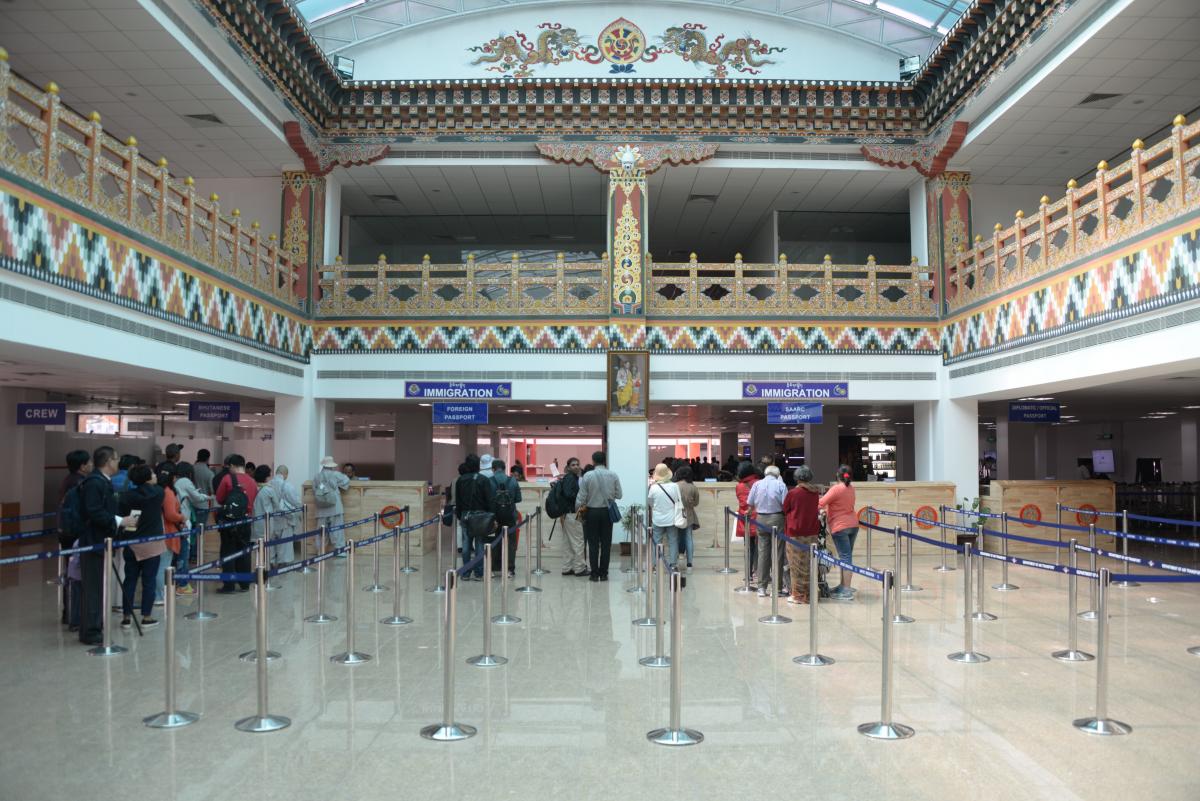
The immigration hall at Paro Airport. Like every Bhutanese building, Paro Airport is constructed according to the rules of traditional architecture and decorated with traditional paintings and carpentry. The terminal building was commissioned in 1999 but looks just like any 17th-century fortress or monastery. (Photo: Peter Bilak)
Every building in Bhutan, every shop, warehouse, home, school, sewage plant and tractor dealership echoes this ethereal design, from the layered cornices under the eaves to the ornamental paintwork. Materials vary, but proportions are precisely followed. Each window is tall, narrow and arched. All roofs are gently sloped. Walls are uniform blocks of colour, detailed in vivid colours from a natural palette. There are no billboards and no bright shop signs.
The citizens of Thimphu, Bhutan’s capital, are equally distinct. The Bhutanese gho, a knee-length belted robe worn with wide white cuffs, is as commonplace on Thimphu’s men as collared shirts might be in a European city. Women wear its equivalent, the kira, a colourful, ankle-length wraparound dress, with a light shirt and a short-sleeved jacket. There are no business suits and no Western dresses.
For the mountain kingdom, establishing a clear national identity is crucial, as both their neighbours have a history of annexing small Himalayan kingdoms. The national dress, language, and architectural style have become important tools for defining the nation, differentiating it from its neighbours.
Walking into Thimphu may feel like stepping back in time, but this uniformity is actually new. In the mid-1980s, many of Bhutan’s modern buildings looked much the same as any construction project in India. Students returning from their studies abroad walked the streets in suits and collared shirts. The young wore jeans and Western T‑shirts. Bhutan had strong traditions, but two decades after opening up to the world, fresh ideas were coming in along with international aid. Then in 1989 the clocks rolled back.

Jigme Singye Wangchuck (aka K4) became the king of Bhutan in 1972 at the age of 17 and is credited with many modern reforms in the country, including the development of the country’s infrastructure, the introduction of the GNH principles, the unconventional ‘high-value, low-volume’ tourism policy, and the imposition of democracy. Most of all, the Fourth King emphasised the country’s self-reliance, sovereignty and independence. (Photo: Ernst Haas/Getty Images)
You don’t have to look far in Bhutan to find the man responsible. He gazes out from badges pinned to clothes and from roadside banners. He looks down on you from a doorway as you emerge from the dark of a cinema screening, then watches you from a wall calendar as you eat in a restaurant. His face, emblazoned on the side of a hangar at Paro Airport, is the first thing you see when you arrive and the last thing you see when you leave. The handsome countenance of Jigme Singye Wangchuk, the retired fourth Druk Gyalpo or Dragon King (the official title of the King of Bhutan), is everywhere in Bhutan, along with images of his son, Jigme Khesar Namgyel Wangchuk, who succeeded him in 2006. Widely referred to as K4 and K5, the merchandise of their monarchy is as much a symbol of Bhutan as the national architecture and dress code. They are wildly popular, and with reason.
When the Wangchuk monarchy came to power in 1908, Bhutan was an impoverished feudal state run by rival warlords and a national monastic body. The kings unified the country and replaced feudal brutality with the rule of law. They ended slavery and serfdom, instituted land reform and introduced citizenship, a civil service and a national assembly. At their command, the country’s few resources were devoted to providing roads, electricity, a postal service, free education and free healthcare. Thirty-four years after being crowned at the tender age of 17, K4 ended the absolute monarchy. In 2008, Bhutan became a democratic constitutional monarchy, in which the king functions as the head of state but must retire at 65. Today, according to Transparency International, Bhutan is the least corrupt country between the Gulf of Thailand and the Baltic Sea.
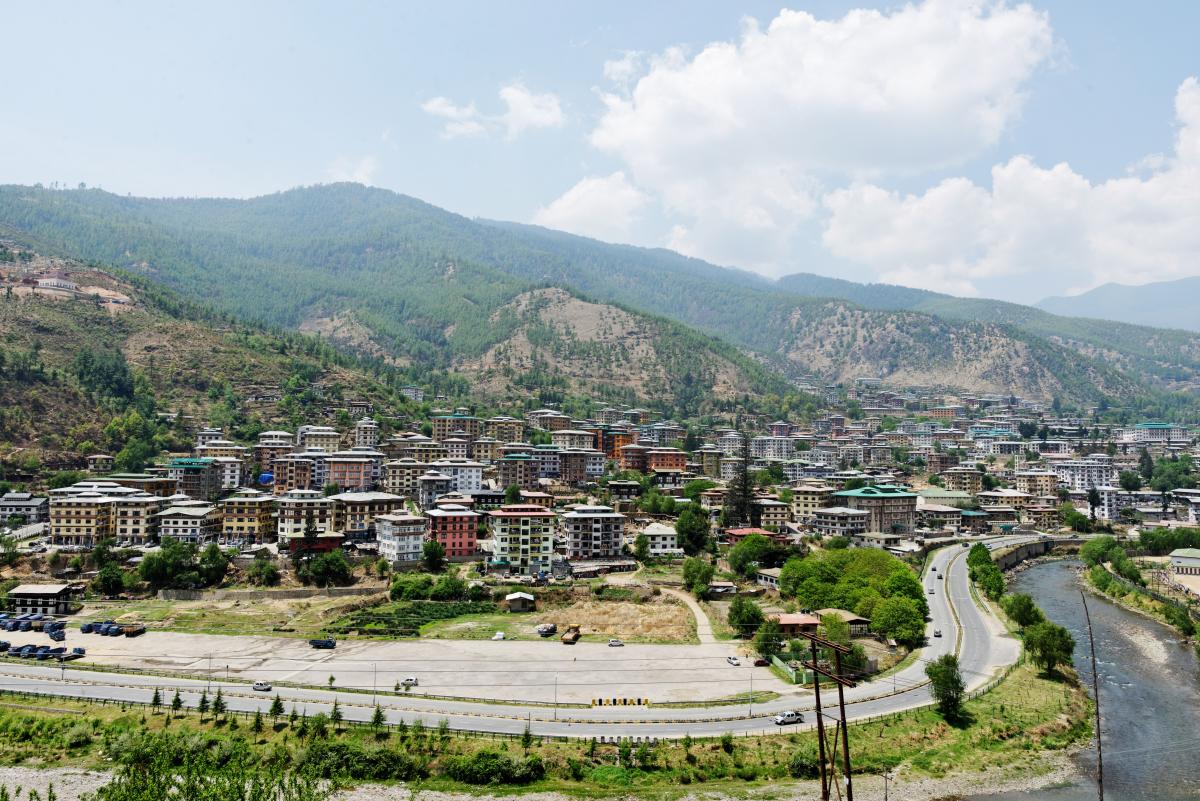
Thimphu, the capital and Bhutan’s largest city, is home to some 100,000 inhabitants. The city has expanded rapidly in the last 15 years, and most of the city’s buildings are less than ten years old. (Photo: Peter Bilak)
For all of this, the simple existence of Bhutan may be the monarchy’s greatest achievement. The landlocked state is a tiny mountain nation of less than a million people, perched on the border between the world’s two most populous countries. Ugyen Wangchuk, the first Druk Gyalpo, played to the strengths of this precarious situation, and made a deal in 1911 with the British Raj. Bhutan’s fertile southern lowlands had been lost to the British in 1865, but its rugged Himalayan highlands had never been occupied by another country. In exchange for financial aid, Bhutan agreed to act as a buffer zone, keeping soldiers of the Chinese Qing government an extra 200 km (124 mi) from Indian territory.
Bhutan gained even greater strategic weight when the British left the region in 1947. The peculiarities of Partition forced newly independent India to rely on a narrow, low-lying corridor of land, the so-called ‘Chicken’s Neck’, in order to reach its northeastern states. Bhutan and its neighbouring Himalayan kingdom, Sikkim, loomed over this vulnerable artery. In 1949, India doubled the aid it sent to the Wangchuk monarchy and reaffirmed the old arrangement, swapping the words ‘British Indian Empire’ in the treaty for ‘Republic of India’.
‘Why am I Bhutanese? It’s not because I am wearing this gho. What really makes us Bhutanese?’ Phub T. Tshering
It was a wise precaution. One year later, China annexed Tibet and became a very real threat along India’s northern border. India declared its intention to protect Bhutan, and backed up its words with yet more investment in the country, building roads and airstrips to defend against the Chinese; crucial infrastructure that propelled the nation into the modern age. Bhutan’s first five-year plan was funded entirely by Indian aid.
Suddenly, Sikkim collapsed. Even now, the circumstances are murky. There may or may not have been a coup. India may or may not have been invited to intervene, and Indian troops may or may not have placed the king under house arrest in his own palace and compelled him to sign away the nation’s independence. What is clear is that pro-Indian politicians called a referendum in 1975 and reported that 97.5% of Sikkim’s population had voted to abolish the monarchy. India annexed Sikkim.
Almost overnight, Bhutan’s best friend became an existential threat. From Thimphu, it seemed that Sikkim had been destabilised by an ethnic Nepalese majority at odds with an indigenous ruling class. Perhaps only a stable Sikkim could keep the Chicken’s Neck safe, which was why India had stepped in. Perhaps, too, streams of exiled Tibetans passing through Bhutan had underlined the value of a distinct national culture, recognised and defended by the United Nations. By the 1980s, according to Karma Phuntsho’s authoritative History of Bhutan (2013), the young K4 had arrived at ‘a realisation that Bhutan’s unique cultural identity, in the absence of military might or economic power, was its defining strength for its sovereignty’. For the mountain kingdom, cultural identity was now a matter of life or death.
As tiny as Bhutan is, however, its cultural identity is a matter of some complexity. Its isolated valleys and forests shelter a wide range of ethnicities, speaking at least 19 indigenous languages. No single group constitutes a majority of the Bhutanese people, but three distinct ethnicities account for around 80% of the population. The smallest of these, the Ngalop, in the west and north of the country, are Bhutan’s ruling elite. The oldest are the Sharchop in the east, and the newest are the Lhotshampa, ethnic Nepalese who have been arriving in southern Bhutan since the mid-19th century. Both Ngalop and Sharchop follow Mahayana Buddhism. The Lhotshampa are historically Hindu.
In 1985, ten years after the fall of the Sikkim monarchy, K4 radically revised his father’s inclusive citizenship policies. With immediate effect, anyone unable to prove that they were permanently resident in Bhutan before 1958 was to be stripped of their citizenship. They were welcome to reapply, but, in a country where adult illiteracy was the norm, would have to prove their understanding of Bhutanese culture in a written test. Two years later, the sixth five-year plan presented the ‘preservation and promotion of national identity’ as one of its prime policy objectives, not ‘because of sentimental values or to uphold past practices, but [as] crucial steps […] to consolidate and safeguard the sovereignty and security of the nation’.

Driglam Namzha, the code of Bhutanese social norms and conduct, includes rules on how to dress. Wearing traditional clothing had long been ‘recommended’, but in 1989 a royal decree made it mandatory during business hours or when in public. The gho, a knee-length robe tied with a belt, is often worn over t-shirts, trousers and shoes that tell more about the individual identity of the wearer. (See also the photo essay ‘Undercover Identity’.) (Photo: Ugyen Wangchuk)
On January 16, 1989, K4 issued a royal decree. With immediate effect, a Bhutanese Buddhist set of ceremonial social doctrines called Driglam Namzha, or the ‘code of discipline’ was to be rigorously applied across public life. Gho and kira were made mandatory national dress in public during working hours, and failure to comply would incur a fine. Dzongkha, the dialect of the Ngalop elite, which had first been set down in writing in the 1970s, was emphasised as the national language. All architecture was to conform to a model ‘improved traditional house’ constructed in each of Bhutan’s 20 dzonkhags, or provinces. The remaking of the nation was underway.
The only people in Bhutan who did not traditionally wear gho and kira were the Lhotshampa. Many did not even own the items. As an incentive, policemen were permitted to keep half of the 100 ngultrum (€1.34 or US$1.50) fine they collected for every breach of the dress code, and soon, as the government later admitted, ‘overzealous functionaries’ in the south were enforcing the new rules in ‘a provocative manner’. When the state stopped the teaching of the Nepali language in primary schools, Lhotshampa took to the streets in protest.
A quarter of a century later, it is still taboo to discuss this period inside the country. All sides agree that the early 1990s saw unrest in the southern districts, that the army and militias from the north became involved, and that many Lhotshampa left. It is a matter of record that K4 visited communities in person to plead with them not to go, but by the end of the decade, over 97,000 people claiming to be from Bhutan, equivalent to one-seventh of the country’s population, were living in refugee camps in Nepal. Their testimonies, collected by Professor Michael Hutt at SOAS, recount forced evictions, official harassment, and torture. Denied entry to Bhutan, almost all of those living in the camps were resettled between 2008 and 2015, as many as 84,000 in the USA alone.
However, many Lhotshampa never left Bhutan, opting to stay in a restrictive nation where television was banned and free speech was unknown. Today they make up around 20% of the population, all wear gho and kira, and those that I encountered were proud to be Bhutanese, in private as well as in public. For all its faults, if Bhutan is defined by its differences from its neighbours, it is a beacon of stability in a troubled region. To the north, China has demolished sacred sites in a violent repression of human rights. To the west, Nepal has been devastated by endemic corruption. And to the south, at least for many Bhutanese, India is represented by Jaigaon, an anarchic border town through which almost all their imported goods must pass. When asked to describe the city, Lewis Beardmore, an India-based anthropologist, hesitates before replying, ‘Have you seen Mad Max?’
In 1998, K4’s royal government put a name to its controlled approach to progress. Gross National Happiness, or GNH, emphasises the primacy of a sense of personal security over and above economic growth. As autocratic rule receded and democracy took its place, GNH emerged as a guiding principle composed of four core elements: good governance, sustainable socio-economic development, environmental conservation, and the preservation and promotion of culture.
Dasho Karma Ura, President of Thimphu’s Centre for Bhutan Studies, led the project to shape GNH and helped to draft Bhutan’s first Constitution. As such, he is one of the prime custodians of Bhutanese tradition in the transition away from dictatorship. ‘We all know that culture will change,’ he explains. ‘It is ever changing, but it is wise to regulate the speed of change.’ If that speed is uncontrolled, he adds, ‘society becomes fragmented. As a small country, we must have some sort of gravity within ourselves.’
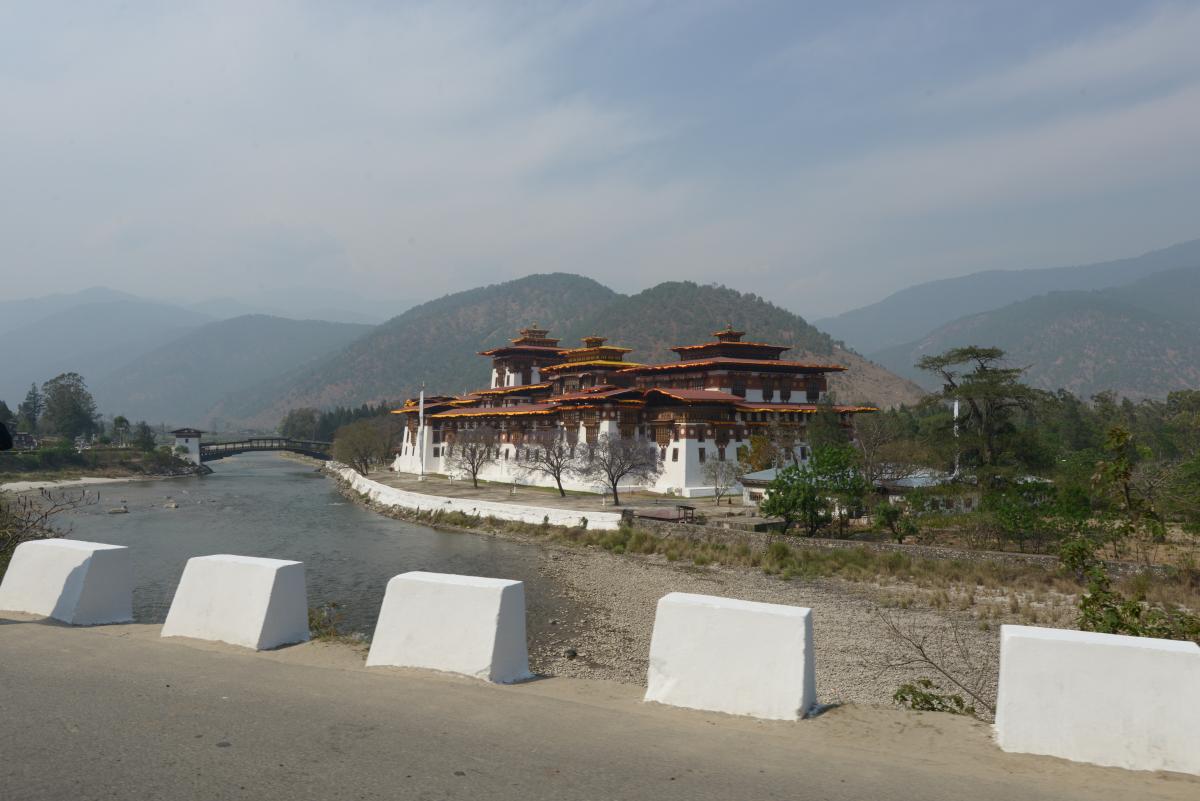
Punakha dzong, a district administrative center and one of the oldest and largest dzong in Bhutan. (Photo: Peter Bilak)
Across Bhutan, Dzongs, monolithic monasteries, fill dips in the landscape like paperweights holding down a map. They are the original anchors of the Bhutanese state, and remain its prime bastions of spiritual and administrative power. In the centre of each one, past offices, through inner courtyards, in sanctums closed to the world, daily prayers take place in a damp, scented gloom. With a heavy, harmonic growl, chanting monks draw out the syllables of tantric mantras, gradually sliding from note to note. Like Dasho Karma Ura, they are preoccupied with time. Their low, slow, singing seeks to extend the present moment, aspiring to a life with no future and no past.
On the floor of a farmhouse in the Pobhjika valley, I sit with a family after dinner and watch monks on a small TV. It is a phone-in programme, and members of the public are ringing in with questions. In accented English, an offscreen voice asks ‘How can I negate my ego, when I am an I, the I is ego… and I focus on my ego… against my ego…?’ From the looks on their faces, the monks are struggling. So am I, and I go to sleep on a mat in the family shrine room, under yellowed postcards of a Rinpoche and an altar of plastic flowers. In the morning, as I stand outside to brush my teeth, I count the crude wooden penises suspended under the eaves of the house. There are five. I rest on a handrail, look down and see that its end has been carved into a graven glans. Startling at first, Bhutan’s phallus cult swiftly becomes familiar. The exterior walls of Bhutanese homes are frequently adorned with two-metre-high paintings of erect male genitalia. Tumescent or mid-ejaculation, they may have wings or eyes, their shafts encircled by smoke, dragons, or the fingers of a hand, and all are lovingly, carefully rendered. They are seen as holy guardians, keeping evil spirits away. Almost certainly, phallus worship is descended from ancient animist tradition, but it has long been absorbed into Bhutan’s Buddhist system through stories about Drukpa Kunley, the ‘Divine Madman’, a picaresque preacher from the 15th century.
This knack for nesting the old inside the new runs right through to the present day. Alongside the government ministries of the fledgling democratic state, there is a national institute for astrology manned by a hundred monks, ready to be consulted prior to major occasions. Free basic healthcare may be provided in clinics throughout the country, but so is traditional healing. Bhutanese practitioners of folk medicine are educated in national schools, officially certified, and specially trained to recognise serious conditions that require referral to a modern doctor. In many developing countries, people’s preference for indigenous medicine is a major problem. Bringing it into the mainstream doesn’t just respect local beliefs; it’s also a way to reach the whole population, and give help to all who need it.

Football fans enjoying the Thimphu Premier League match at the Changlimithang Stadium, the Bhutanese multipurpose national stadium that usually hosts football games, archery tournaments (the national sport of Bhutan), and that witnessed the coronation K4 and K5. Unlike a typical Thimphu scene where people are wearing ghos and kiras, such traditional clothes are rare at an evening football game. (Photo: Peter Bilak)
On the surface, change in Bhutan moves at a glacial pace. Bhutanese democracy is eight years old, yet the same political elite run the country as before the transition. Thimphu has expanded rapidly since 2000, but it is hard to say which buildings are new, as all are all built to the same aesthetic guidelines. The woman’s kira has developed two new variations in recent years, yet these innovations are so subtle that, under the toego jacket, they all look identical. For citizens living in an unchanging world, old cautions can be hard to shake. Police fines for failures to observe Driglam Namzha were discontinued over a decade ago, yet locals may still worry when they should or should not wear national dress.
‘Use your good sense and judgement,’ was K4’s advice on June 2, 1999. It was the 25th anniversary of his coronation, and standing at a golden podium in Thimphu’s football stadium (where the pavilion, naturally, resembles a temple cloister) he was announcing his fateful decision to introduce television and the Internet to Bhutan. ‘It is my sincere hope that the introduction of television will be beneficial to our people and country,’ he continued, ‘but not everything you see will be good.’

Driglam Namzha the code that governs Bhutanese cultural norms, covers everything from dress and formal behaviour to art and architecture.. Even modern buildings such as football stadiums, power plants, car dealerships and this petrol station in Thimphu adhere to traditional models. (Photo: Peter Bilak)
Filtering out the bad bits is the job of BICMA, or the Bhutan InfoComm and Media Authority, the media regulatory body of a nation where critical voices have struggled to take off and the independent press breaks little hard news. Yet this is far from a board of ruthless state censors. An inquisitive visitor is more than likely to be offered tea and something like sympathy by Chencho Dorji, BICMA’s humble, thoughtful Director General, a man responsible for overseeing functions that range from facilitating mobile phone coverage in remote areas to issuing film certifications. With only 18 staff, there is no time to be a ministry of propaganda, too. ‘BICMA could never inculcate a sense of culture,’ he says. ‘That would be like a policing job. It would almost be like a dictatorship, and that is not going to work any more now. Even as a parent, there is no point tying your children up and saying “You can’t go to the disco, the disco is bad”. You have to educate your children about why the disco is bad. If we can’t do that to our own children, how can BICMA do that to society at large?’
I go to the disco to see if it bad. On the laser-lit dance floor, young Thimphu men and women dance to Flo Rida and Rihanna. Mixed groups dressed in casual Western clothes chat boozily over white leather upholstery. The only sign that the establishment is in Bhutan is a leafy wad of doma, chewed betel nut, blocking a sink in the men’s bathroom. At an afterparty, conversation revolves around Game of Thrones and the lyrics of Stormzy, an independent rapper based in London.
Little of this culture has arrived through TV. Cheap smartphones brought in from Jaigaon or flown in from Bangkok are quietly revolutionising Bhutanese society. Today, a third of the population are on Facebook and even greater numbers are signed up to WeChat, where people send audio messages to each other in groups. According to UNICEF, around half of Bhutanese adults are illiterate, and not only does WeChat allow them to share news, but it also lets them do it in whatever language they like. By the side of a path in Paro, in the west of Bhutan, a middle-aged lady selling souvenirs shows me a two-year-old smartphone she uses to talk to her family in Trashiyangtse, on the country’s eastern border. They speak Tshangla with each other, the majority language among the Sharchop people, and one which has no written form.
At a stroke, society has leaped ahead of the government framework designed to slow the pace of change. According to Dasho Karma Ura, they are ‘not so disruptive. They are just tools, you can use them how you want, but like TV, they should not overpower you’. Unlike TV, however, using the Internet is not a passive experience. Once stifled under authoritarian rule, a thriving civil society is emerging online. Social media in Bhutan is being used to organise social care, arrange cleaning campaigns and keep tabs on public toilets. But the door to the outside world has been flung wide open, too. Nearly everyone asked about smartphones mentions the problem of pornography. Almost exclusively American, it arrives through WeChat, sent by anonymous pranksters. For people like the souvenir seller, who uses WeChat to share photos of Tibetan monasteries and her favourite Buddhist Lama, the clips from California are a frightening intrusion into an innocent world.
There is not much that BICMA can do about it. ‘It is totally illegal to share pornography,’ explains Phub T. Tshering, the elected administrator, or ghup, of Lamgong Gewog in Paro district, ‘but the police cannot find out who puts it on WeChat. They send requests to Hong Kong, where WeChat is based, but WeChat won’t give them the information.’ Kuensel, Bhutan’s only daily newspaper, is widely read, but the former state agency breaks stories days after they occur and heavily moderates any criticism of the government. On WeChat groups and Facebook, there is no such censorship, nor any burden of proof. In the past, media control has relied on Bhutan’s small size; in a nation of 750,000, everyone knows everyone, and people self-censor. Anonymous accounts online are completely beyond such restraints.
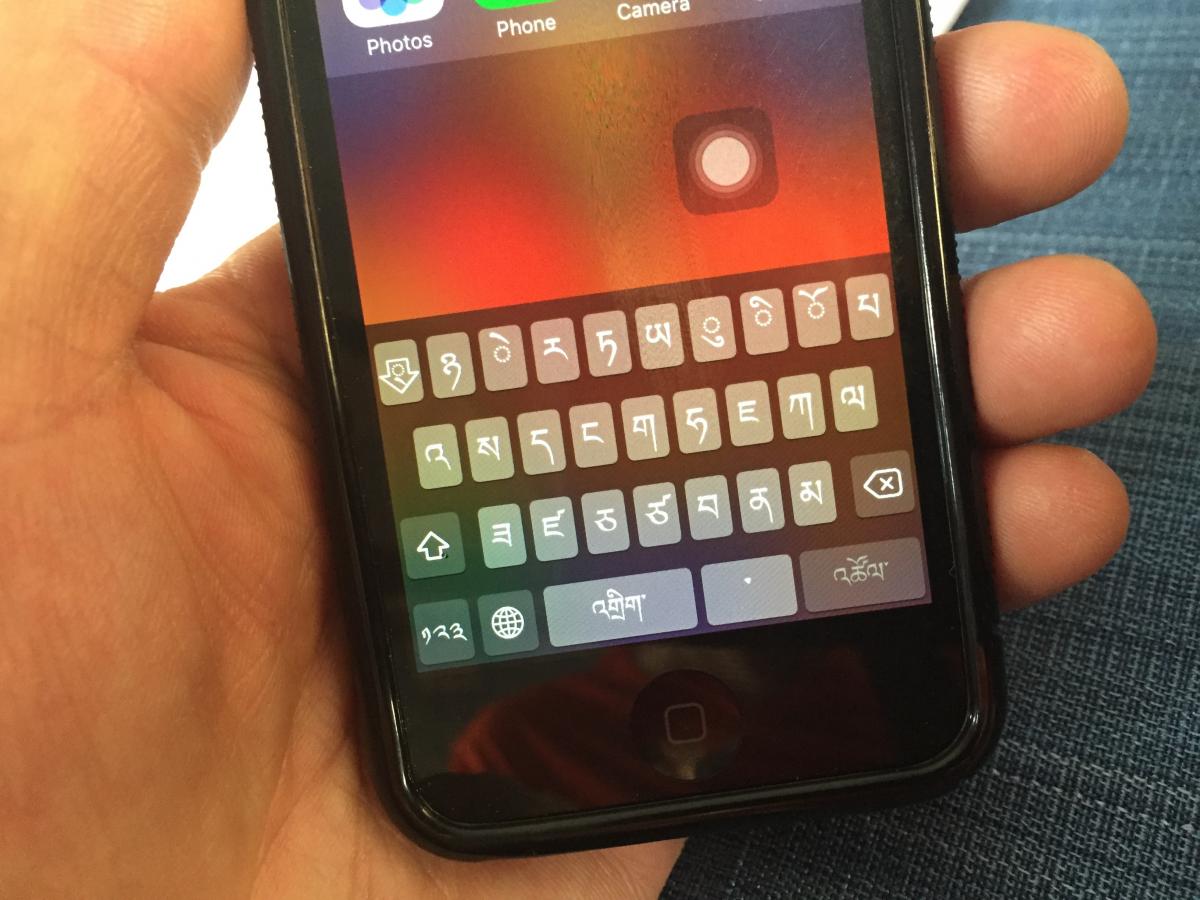
Dzongkha was declared the official national language of Bhutan by the Third King of Bhutan in 1971. Since 2010 smartphones have supported the Tibetan script in which it is written. Propagation of the language has been instrumental for the preservation and promotion of Bhutan’s culture. (Photo: Peter Bilak)
The impact on politics has already been profound. In 2013, during Bhutan’s second democratic election, a scurrilous blog called Bhutanomics ripped into the ruling party. ‘My god,’ says Chencho Dema, ‘the way they wrote. Cartoons. The content. You can’t imagine how they had access to such secret information. Everyone was accessing that blog. And it was an unknown enemy. You didn’t know who to prosecute.’ A failed attempt to block the site, involving the Druknet ISP and, possibly, BICMA itself, only made things worse. Tshering Tobgay and his PDP swept to power on a landslide, and once the new government was installed, the stream of wild accusations dried up and disappeared. ‘Looking back now,’ says Chencho Dema, diplomatically, ‘I would say it had a political motive.’
In August 2016, in what is widely seen as a crossroads for Bhutanese free speech, the outspoken journalist Namgay Zam was prosecuted for defamation, having shared a Facebook post alleging criminality by the father-in-law of Bhutan’s Chief Justice. ‘On Facebook we can control things,’ says Phub T. Tshering. ‘But on WeChat, we can’t.’ Unfortunately for Bhutan, the Chinese government can. Speaking at The Carnegie Council in the same month, Professor Joshua Eisenman at the University of Texas at Austin described witnessing a WeChat message by a government dissident transform into an innocuous article about Chinese dumpling vendors. Chinese power may have found a back door.
Every five years, Dasho Karma Ura and his team at the Centre for Bhutan Studies carry out a GNH survey on a representative sample of 8,000 citizens. It is a check-up on the nation’s wellbeing, as defined by the four GNH pillars. To determine the nation’s cultural health, an assessment is made of the state of artisan skills, speaking a native language, participation in cultural activities, and Driglam Namzha, the national code of dress and behaviour. Preliminary results for the 2015 GNH Index show that the Driglam Namzha indicator is down by 17%. Worrying, perhaps, but the 2010 GNH Index found that a full 93.4% of the population thought Driglam Namzha was ‘very important’. Bhutan’s culture, the report concludes ‘is stable’.
Twenty-seven years after they were formally introduced, Bhutan’s rules on clothing, architecture, and the outward symbols of nationhood are now ingrained elements of the national character. Out in the countryside, children peer into a cracked phone screen to watch Ap Bokto, a cartoon about a man dressed in a gho. By Paro airport, guides waiting for tourists record each other singing traditional songs. Unwritten local languages are being kept alive. Communities are growing closer. And, amongst 1.7 billion Facebook users, perhaps it pays to be wearing something different.

